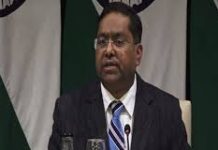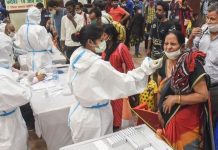
In 2005, Rajkumar Tiwari, a clerk at a transport company in Indore, had a son. The mother and child were doing well, and Tiwari was happy. At the end of the first month, his wife took the baby to Chacha Nehru Bal Chikitsalaya, a children’s hospital attached to Indore’s largest public hospital, for what they thought was a routine inoculation. She was made to sign a few papers, after which the baby was given two injections on his heel by paediatrician Dr Hemant Jain. Within 24 hours, their child was dead.
Ashish Jatav was luckier. A day after his son was born, the embroidery worker received a call from the same hospital asking him to bring the child. His wife and mother took the child there, where he was given what Jatav thinks was “some kind of polio vaccine” by Dr Jain. In all, the child received “either three or four” doses. That was in 2008.
Tiwari put his son’s death down to fate. “I didn’t even try to contact the hospital,” he says. And Jatav didn’t make any further enquiries about the vaccine his son had received.
That’s where matters would have rested had it not been for a question on clinical trials that cropped up in the Madhya Pradesh Assembly in late 2010. In response, the health department submitted a list of 81 people who had been enrolled in clinical trials between 2006 and 2010. That, shockingly, is how Tiwari and Jatav realised that their children had been used as guinea pigs in clinical trials.
The papers their illiterate wives had been made to sign had been passed off as the ‘informed consent’ that is required from participants in clinical trials. They had been given no verbal explanations, nor were they given copies of the documents they had signed. They had trusted the doctors of Chacha Nehru Bal Chikitsalaya, the city’s largest public children’s hospital.
Investigations by the state government and RTI requests from activists revealed that Dr Jain was conducting these trials for Panacea Biotec, a large Delhi-based pharmaceutical company. Jatav’s son was given drops of an untested polio vaccine, and according to PD Karan of Panacea, Tiwari’s son got the Haemophilus influenzae type B conjugate vaccine.
In its defence, Panacea claims that all participants in their trials were given consent forms in Hindi, which were subsequently approved by the hospital’s ethics committee.
The company says that of the 640 children involved, three died during the trials. Panacea claims that none of the deaths was related directly to the trials.
However, Panacea was not the only company for which Dr Jain was running trials. According to a report by the Madhya Pradesh government’s Economic Offences Wing, he conducted clinical trials on 2,500 patients for a number of different companies between 2006 and 2010. There were 18 deaths during the course of these trials, none of which was investigated by any independent agency.
Dr Jain, a government doctor, was paid Rs 1.7 crore for the trials. Not a penny of that went to the hospital. Dr Jain says he is “not interested in answering any questions”.
“We might be poor,” says Tiwari angrily, “but even the poorest wouldn’t subject their children to a trial vaccine.”
India emerged as a global pharma destination in 2005 when it amended patent laws to recognise product patents. Also amended were the rules that required foreign companies to conduct clinical trials in India only after they had successfully completed trials abroad. Now, companies could conduct trials in India concurrently and use clinical trial data generated in India for their patent applications abroad.
The clinical trial market burgeoned, growing from almost non-existent to one that the Boston Consulting Group estimates is now worth $400 million a year.
However, India’s regulatory infrastructure and the laws governing the pharma sector had not changed significantly. They were completely inadequate to control an industry that had been growing at over 20 percent every year.
As new details emerged in Madhya Pradesh, the issue simmered. Anand Rai of Indore-based NGO Swasth Samarpan Seva Samiti tried to get in touch with all the 81 participants, and filed RTI requests to unearth more details about the trials.
Then, last January, Swasthya Adhikar Manch, another Indore-based NGO, filed a case in the Supreme Court alleging that the Madhya Pradesh government had allowed completely unregulated, large-scale clinical trials of a whole array of drugs. In a writ petition, it alleged that many other states had done the same. It wanted the Union health ministry to provide details about the number of people enrolled in clinical trials, the number of deaths and the compensation given.
And that cracked open the anarchic can of worms that the pharma establishment in India (both government and private) had become. It was going to be a year of more revelations and indictments. What happened in Madhya Pradesh had also happened in Uttar Pradesh, Rajasthan and many other states.
The chaos in clinical trials, it emerged, was mirrored by regulatory laxity in drug control and the government’s tacit submission to various vested interests on intellectual property issues.
The blowback was swift. The furore on clinical trials was followed by a scathing Parliamentary Committee report on the functioning of the Central Drugs Standard Control Organisation (CDSCO), the apex body for drug approval and the regulation of clinical trials in the country.
At the same time, the Indian Patent Office rejected a number of major patent applications of pharma MNCs, and issued the first compulsory licence for the manufacture of a drug in India. This lead to a drastic reduction in the prices of critical drugs used to treat diseases like cancer.
The government also took a conservative stand on FDI in pharma, unlike what it was doing in most other sectors. The Department of Pharmaceuticals introduced a new drug price control system, the first amendment since 1994.
In the meantime, the Planning Commission was working on a broader canvas, suggesting changes that would refocus India’s health policy in the 12th Five Year Plan period (2012-17) on public health. The individual regulatory processes had started earlier, but in 2012, the strands coalesced into what will hopefully become a comprehensive net.
Everyone in the pharma industry has been affected. In a departure from the norm, the three government departments that handle pharma issues — the ministries of health; chemicals and fertilisers; and commerce — have spurred into action.
Pressure from civil society and the SC’s intervention has set into motion a series of regulatory changes in the pharma establishment that will have far-reaching consequences, determining the path of the industry over the next decade.
“It was the year when drugs took centrestage,” says Dr Ranjit Roy Chaudhury, who has worked with the government, the WHO and a number of private research organisations on health policy. “Public consciousness has been raised, and today more than ever before, there is demand for better control and availability of medicines and the rational use of drugs.”
But greater government regulation has meant reduced profits for the pharma industry, and that has not gone down well. So rattled is the industry that Tapan Ray, the head of the Organisation of Pharmaceutical Producers of India, hopes that “what happened in 2012 will not be a general trend in the future”.
Unfortunately for him, the ball has already been set rolling. What started last year is gathering pace, and will be refined by a series of reports and court orders that are expected. It’s leading to greater transparency and accountability in the government’s health regulation and in the private medical and pharma industry.
When Rai filed an RTI request with the Drugs Controller General of India (DCGI) asking for data on clinical trials, he was first stonewalled. Then emerged a smorgasbord of conflicting data. All of it seemed to point in one direction.
Not only did the apex drug control body (of which the DCGI is the head) not maintain a central database of clinical trial deaths, but there was little monitoring of trials or the compensation paid to victims who suffered serious adverse drug reactions. This was despite the fact that all clinical trials post 2009 are required to be registered on the Clinical Trials Registry.
That the monitoring of clinical trials had been almost non-existent became obvious by the end of 2012, as the government pulled out different, often conflicting data.
According to the DCGI, there had been 2,031 deaths during clinical trials between 2008 and 2011. 668 of these had taken place in 2010, of which 22 were directly related to clinical trials. In these cases, the companies conducting the trials had paid varying compensations, but the DCGI was not aware of the amounts.
The ethics committees overseeing clinical trials were responsible for deciding whether a death was related directly to it. In a clear conflict of interest, these committees were, according to Rai, “composed of members from the institutions where the trials were being held”.
The DCGI did not furnish data for the other years. “The data of respective trial sites and their respective states is not maintained by this directorate,” it averred. No action has been taken against the drug companies, clinical trial research organisations or the hospitals involved.
In the meantime, other data emerged in an answer given by Union Health Minister Ghulam Nabi Azad in response to a question in Parliament. According to him, there were 16 deaths each in 2009 and 2011. Compensation had been paid in all cases that occurred in 2011.
The government had no rules on compensation to the victims of clinical trails, therefore the money doled out by the companies in all these cases had been at their discretion.
Yet more data emerged from the case filed by Swasthya Adhikar Manch in the SC. In an affidavit filed on 3 January by R Chandarashekar of CDSCO, the government claimed that between 1 January 2005 and 30 June 2012, there had been 2,644 deaths during clinical trials. Of these, 80 were directly due to the trials. Compensation had been paid in the 40 cases that occurred in 2008-11; and the agency was “now ascertaining the status of such cases pertaining to the year 2005 onwards”.

The figures from all the sources above were at variance. Azad’s reply in Parliament put the deaths in 2009-11 at 54, whereas the CDSCO affidavit put it at 40 for a longer period!
A similar state of confusion prevailed when it came to the number of patients enrolled in clinical trials across India.
Those who had suffered serious adverse reactions were completely ignored. The CDSCO affidavit put their numbers at 11,972 (for the same period), of which it stated that 506 were related to clinical trials. The CDSCO was not aware if any compensation had been paid in these cases.
Matters only got murkier.
Not only did the drug controller not have any reliable data on clinical trials, Azad’s reply revealed that it had conducted only 23 inspections of trial sites and companies in 2008-12. Shockingly, during this period, the same agency had allowed the clinical trials of 1,544 drugs.
All this had worked in favour of the growing clinical trial industry with clinical trials of drugs that Mira Shiva of the All India Drug Action Network says are “largely irrelevant to India”.
India was a cheap destination for pharma MNCs to conduct clinical trials (for drugs to be marketed abroad), and there was a huge pool of people to be used.
Ironically, while on the one hand these clinical trials were growing, the drug control agency was increasingly letting pharma firms introduce new drugs in India without conducting mandatory clinical trials.
In a May 2012 report, which Dr Chaudhury calls “remarkable” and “unprecedented” for its brutal honesty, a Parliamentary Standing Committee pointed out these glaring violations.
Randomly scrutinising the approval of 42 new drugs given by CDSCO, the committee found that files for three controversial drugs were untraceable.
Of the remaining 39 for which the files did exist, 11 drugs were not put through mandatory phase III trials. Thirteen drugs were not approved for sale in any major developed country (including Buclizine, a controversial appetite stimulant for children) and had no “special relevance to India”. For 25 drugs, approval had not been taken from medical experts.
In all, the regulator had waived the mandatory clinical trial requirement for 31 drugs between January 2008 and October 2010. This included Ambrisentan, a hypertension medication manufactured by GlaxoSmithKline, and Colistimethate, an antibiotic made by Cipla, which were likely to be used widely.
More worryingly, it pointed out that most of “expert opinions” justifying the waivers were “written by the invisible hands of drug manufacturers and experts merely obliged by putting their signatures”.
“The clinical trial system was a complete mess,” says Sakthivel Selvaraj, a health economist at the New Delhi-based Public Health Foundation of India.
AS THESE revelations emerged, the government was forced to act. The CDSCO put out guidelines regulating the ethics committees overseeing clinical trials. The guidelines stipulate that the committees should have at least seven members, including some who are independent of the institution conducting the trial, besides one layperson (not from the medical establishment). It also required the committees to be registered with the state or central licensing authority.
There were also guidelines for the compensation for injuries and deaths related to clinical trials. These took into account the patient’s age, earning capacity and the extent of injury.
The onus of proving that an injury or death was not due to the clinical trial was transferred to the sponsor, and a time frame stipulated within which the victim was to be compensated. Ethics committees were now required to report all adverse reactions to the regulator.
A whole slew of New Drug Advisory Committees were also constituted to advise the CDSCO on the approval of clinical trials and new drugs. Clinical trials of new drugs would now have to be approved by a separate committee controlled by the Indian Council for Medical Research (ICMR).
In its order on 3 January, the SC was even more restrictive, directing that all clinical trial applications be temporarily approved by the health ministry secretary.
A government panel set up to look into the Parliamentary Standing Committee’s allegations on the approval of new drugs has submitted its report, which is yet to be made public. VM Katoch, head of this committee and director-general of ICMR, did not respond to emails and phone calls.
Predictably, the pharma and clinical trial industry is worried. Anil Raghavan, head of the Indian operations of Quintiles, a large MNC contract research and clinical trial company, finds these changes disturbing. “These are knee-jerk solutions to societal concerns,” he says. “They have caused confusion and concern in the industry about the intent and direction of government policy.”
A report from PricewaterhouseCoopers and the Confederation of Indian Industries reiterates this stating that as a result of these changes and the consequent delays in clinical trial approvals “some contract research organisations are looking to increase focus on other geographies”.
That wouldn’t be cause for concern in the case of clinical trials of drugs that are not relevant to India, but it could lead to significant delays in the introduction of important drugs manufactured by MNCs.
In the long run, this regulatory churn seems inevitable, almost overdue. It’s the first step to a more radical and comprehensive overhaul. “Making these changes in our system is very difficult,” says Chaudhury, “this is the start of a process that will play out across the next decade.”
akshai@tehelka.com












